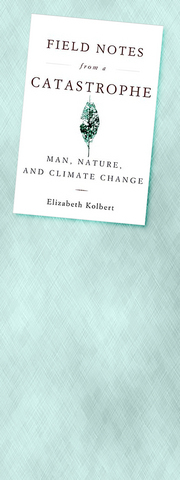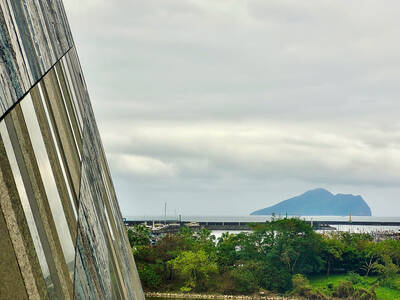"The whole world is going too fast," an Inuit hunter from Banks Island in the Northwest Territories in Canada told the journalist Elizabeth Kolbert at a bar during a global-warming symposium. A few years before, he and his neighbors had started seeing robins, birds they had no name for. At first the milder weather that drew the robins north seemed a good thing -- "warmer winters, you know," he said -- but as other changes occurred that affected their traditional way of life, including hunting, it did not seem so good. "Our children may not have a future," the hunter concluded. "I mean, all young people, put it that way. It's not just happening in the Arctic. It's going to happen all over the world."
For Field Notes From a Catastrophe, Kolbert went not exactly all over the world to find out what's happening with global warming but to a great many places in it, and she often heard the same elegiac expressions of foreboding, loss and fear for the next generation. In Shishmaref, Alaska, she met people who were abandoning their tiny island home because, with less sea ice around it as a buffer against storms, their houses and land were being carried away. ("It makes me feel lonely," one woman said of the forced move.) In Iceland, a man monitoring glacial advance and retreat passed on the prediction that by the end of the next century, his country, where glaciers have existed for more than 2 million years, will be essentially ice-free. On the Greenland ice cap, well away from the coast, researchers gathering meteorological data were surprised to see melt "in areas where liquid water had not been seen for hundreds, perhaps thousands, of years."
And so it went in Fairbanks, Alaska, Yorkshire, Eugene and Oregon. "Such is the impact of global warming," Kolbert points out, that she could have gone to countless other places, "from Siberia to the Austrian Alps to the Great Barrier Reef to the South African fynbos -- to document its effects."

Kolbert, a former reporter for The New York Times, doesn't doubt that human-induced global warming is real and will likely have dire consequences; the title of her book includes the word "catastrophe." The pages are replete with bad news: perennial sea ice, which 25 years ago covered an area of the Arctic the size of the continental US, has since lost an area "the size of New York, Georgia and Texas combined." Carbon dioxide levels, if emissions go unchecked, could reach three times pre-industrial levels by the end of the century.
Based on a series of articles that appeared in The New Yorker magazine, the book is organized around notes Kolbert took on "field trips," not only to places where climate change is affecting the natural world but also to ones -- labs, offices, observatories -- where humans are trying to understand the pheno-menon of human-induced global warming. Hers is the latest in a large crop of books on the subject -- she notes that "entire books have been written just on the history of efforts to draw attention to the problem" -- and there are inevitably some places where other authors have trod before.
In language that is clear, if somewhat dry, she examines the major pieces of the story, shedding light on some insider concepts of climatologists, like "dangerous anthropogenic interference," as she goes. The book may make a good handbook as it is both comprehensive and succinct. (If you have ever wondered how a climate model is put together, that's in there, too.)
She visits the Netherlands, where rising sea levels caused by global warming are expected to swallow up large parts of the country. In areas where there are already periodic floods, a construction firm has started building amphibious homes (they resemble toasters, Kolbert says) as well as "buoyant roads." Another field trip took her to Washington, where she was treated to double-speak by an under secretary charged with explaining the administration's position on climate change. "Astonishingly," she comments in a rare show of heat, "standing in the way" of progress seems to be US President George W. Bush's goal. Not only did he reject the Kyoto Protocol, she notes, with its mandatory curbs on emissions, almost killing the treaty in the process, but he also continues to block meaningful follow-up changes to it.
The US is the largest emitter of carbon in the world, accounting for a quarter of the world's total, with the average US citizen putting out 5,443kg of carbon a year, or about 100 times what the average Bangladeshi does. In two decades, the Chinese will surpass Americans in this disheartening achievement, unless they can somehow be persuaded to build their many projected new coal plants using modern, low-emission -- and expensive -- technology.
Some of the most downbeat (or realistic) observers are climate scientists. "It may be that we're not going to solve global warming," Marty Hoffert, a physics professor at New York University, told Kolbert, "the earth is going to become an ecological disaster, and, you know, somebody will visit in a few hundred million years and find there were some intelligent beings who lived here for a while, but they just couldn't handle the transition from being hunter-gatherers to high technology."
Hoffert isn't giving up in despair, though, but turning to high technology for help. He's trying to find carbon-free sources of energy -- away from Earth. Satellites with photovoltaic arrays could be launched into space, he suggests. Solar collectors could be placed on the moon. Turbines suspended in the jet stream could generate wind power. At least in the long term, "I think we have a shot," he says.
In a final chapter on the "Anthropocene," a newly minted term meaning the geological epoch defined by man, Kolbert turns from her mostly unbiased field reporting to give her own opinion. She is not optimistic, in large part because it appears that Anthropocene man can't be counted on to do the right thing. "It may seem impossible to imagine that a technologically advanced society could choose, in essence, to destroy itself," she writes, "but that is what we are now in the process of doing."

Last week Elbridge Colby, US President Donald Trump’s nominee for under secretary of defense for policy, a key advisory position, said in his Senate confirmation hearing that Taiwan defense spending should be 10 percent of GDP “at least something in that ballpark, really focused on their defense.” He added: “So we need to properly incentivize them.” Much commentary focused on the 10 percent figure, and rightly so. Colby is not wrong in one respect — Taiwan does need to spend more. But the steady escalation in the proportion of GDP from 3 percent to 5 percent to 10 percent that advocates

A series of dramatic news items dropped last month that shed light on Chinese Communist Party (CCP) attitudes towards three candidates for last year’s presidential election: Taiwan People’s Party (TPP) founder Ko Wen-je (柯文哲), Terry Gou (郭台銘), founder of Hon Hai Precision Industry Co (鴻海精密), also known as Foxconn Technology Group (富士康科技集團), and New Taipei City Mayor Hou You-yi (侯友宜) of the Chinese Nationalist Party (KMT). It also revealed deep blue support for Ko and Gou from inside the KMT, how they interacted with the CCP and alleged election interference involving NT$100 million (US$3.05 million) or more raised by the

While riding a scooter along the northeast coast in Yilan County a few years ago, I was alarmed to see a building in the distance that appeared to have fallen over, as if toppled by an earthquake. As I got closer, I realized this was intentional. The architects had made this building appear to be jutting out of the Earth, much like a mountain that was forced upward by tectonic activity. This was the Lanyang Museum (蘭陽博物館), which tells the story of Yilan, both its natural environment and cultural heritage. The museum is worth a visit, if only just to get a

More than 100,000 people were killed in a single night 80 years ago yesterday in the US firebombing of Tokyo, the Japanese capital. The attack, made with conventional bombs, destroyed downtown Tokyo and filled the streets with heaps of charred bodies. The damage was comparable to the atomic bombings a few months later in August 1945, but unlike those attacks, the Japanese government has not provided aid to victims and the events of that day have largely been ignored or forgotten. Elderly survivors are making a last-ditch effort to tell their stories and push for financial assistance and recognition. Some are speaking